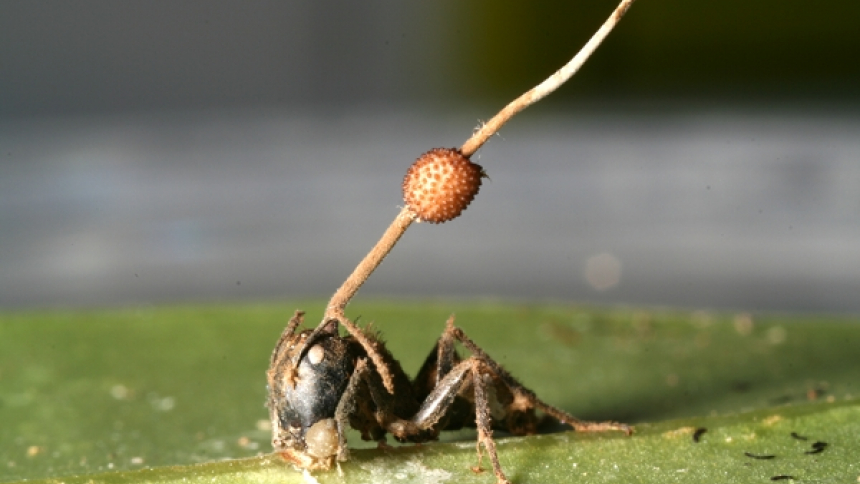Some infectious diseases can manipulate host behavior, utilizing varying mechanisms and expressing a range of responses. One of the most famous examples of host manipulation occurs in ant species belonging to the genera Camponotus and Polyrhachis that are infected with a parasitic fungus (Ophiocordyceps unilateralis sensu lato), referred to as zombie ants. It is a rather sinister story: the carpenter ants are typically ground-dwelling, but when infected, they climb up plants and bite the underside of leaves or twigs where they die; the fungus grows a fruiting body out the ant corpse’s head that is filled with fungal spores; the spores are then released onto the ground where they infect new hosts. Although the ant’s behavioral change has been well characterized, the exact mechanisms of host control have evaded researchers until recently.
The mechanisms behind making a zombie ant were explored by CIDD researchers Raquel Loreto, Colleen Mangold, and David Hughes, along with other scientists from Penn State, Maridel Fredericksen and Missy Hazen, and University of Notre Dame: Yizhe Zhang and Danny Chen. The team used electron microscopy and deep-learning algorithms to create 3D imaging of the distribution, abundance, and interaction of the parasite with host cells. They discovered that about 10% of tissue inside of an infected ant is fungal tissue (by volume) and the most important part of the fungi lifecycle is the fixation near a host’s mandibles. Here, it secretes a tissue-specific metabolite that causes changes in ant gene expression and mandibular atrophy. This forces the ant to bite the underside of vegetation, which is the most optimal spot for the spores to be released onto new hosts. Most intriguingly, the brain remained uninfected. Fredericksen et al. postulate that the fungus controls their host’s muscles by forming a communication network of fungal cells around host muscle fibers. So, the fungus may not need to infect the brain directly, although they cannot rule out the possibility of chemical changes in the brain due to infection.
This research demonstrates that host behavioral manipulation can occur by a parasitic infection outside of the brain and that parasites can affect different host tissues in different ways. Using cutting-edge technology, Fredericksen et al. describe and visualize how zombie ants truly embody their name. This methodology may be used to analyze similar, yet phylogenetically distinct, host-parasite relationships that cause biting behavior in ant hosts. There is still much to learn about zombie ant infections that CIDD researchers are excited to pursue, such as how parts of the fungal networks promote host manipulations without directly contacting host muscles, and the role of secondary metabolites.
Synopsis written by Ellen Brandell
Image is a carpenter ant found in Thailand, killed by the infectious fungus. The fungus reproduces via the fruiting body growing out of the ant’s head, which contains spores that will infect other ants. Photograph from David Hughes.
Publication Details
M. Fredericksen, Y. Zhang, M. Hazen, R. Loreto, C. Mangold, D. Chen, D. Hughes
Three-dimensional visualization and a deep-learning model reveal complex fungal parasite networks in behaviorally manipulated an
Journal: Proceedings of the National Academy of Sciences
DOI Reference




